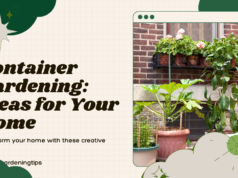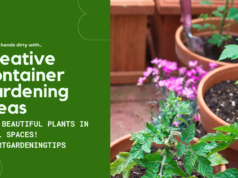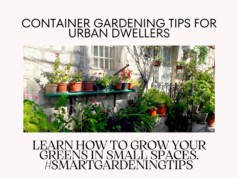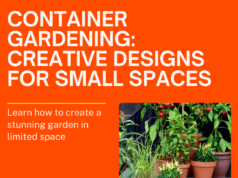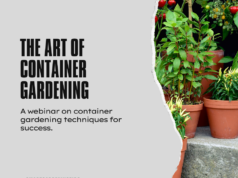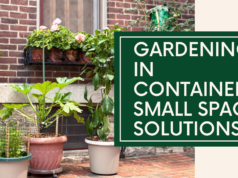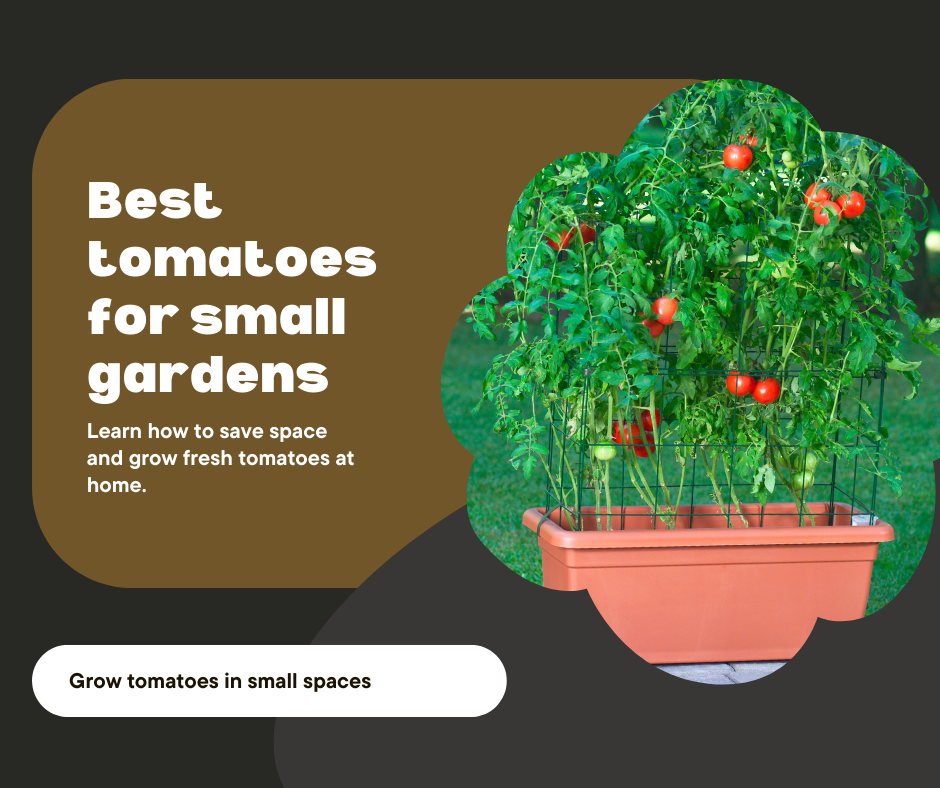
Welcome to our guide on the best tomatoes for limited space gardening! Whether you have a small garden or a cozy balcony, you can still enjoy the delight of growing your own delicious tomatoes. In this article, we will explore a variety of tomato options that thrive in compact environments, allowing you to maximize your limited space and savor the flavors of homegrown tomatoes.
Key Takeaways:
- Compact cherry tomatoes are ideal for small spaces and offer a wide range of flavorful options.
- Patio tomatoes are bred specifically for limited spaces, making them perfect for balcony and patio gardens.
- Roma tomatoes are great for container gardening due to their manageable size and high yield.
- Micro tomatoes are tiny varieties that require minimal room to grow while providing bursts of flavor.
- Understanding the difference between determinate and indeterminate tomatoes can help you choose the right type for your limited space garden.
Compact Cherry Tomatoes: Ideal for limited space gardening
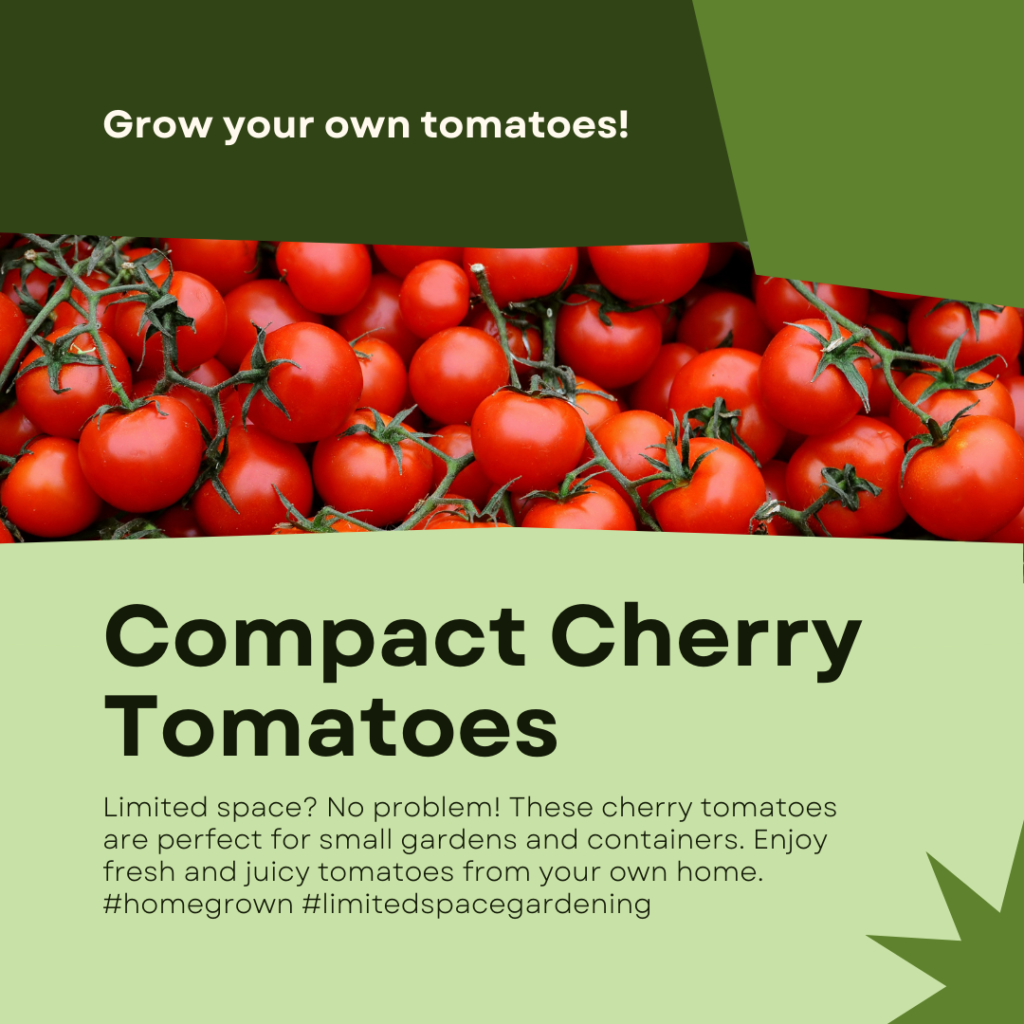
When it comes to limited space gardening, cherry tomatoes are a perfect choice. These small-sized tomatoes are not only packed with flavor but also boast compact growth habits that make them ideal for gardens with restricted space. Let’s explore the different varieties of cherry tomatoes and the amazing flavors they offer.
1. Sweet 100:
The Sweet 100 cherry tomato variety is a popular choice among gardeners. With a rich, sweet flavor and vibrant red color, these tomatoes are a delight to eat fresh or add to salads. The plants typically grow to a height of 5-6 feet, making them suitable for containers or small garden beds.
2. Sun Gold:
For a burst of tropical sweetness, Sun Gold cherry tomatoes are a must-try. These golden-orange tomatoes have a deliciously sweet and tangy flavor. The plants are known for their vigorous growth and yield an abundance of small, bite-sized tomatoes throughout the season.
3. Black Cherry:
If you’re looking for a unique and flavorful cherry tomato variety, the Black Cherry is an excellent choice. With a deep, rich flavor and a touch of sweetness, these tomatoes are as beautiful as they are tasty. The indeterminate vines of the Black Cherry tomatoes can reach a height of 6-8 feet, so providing support is essential.
In addition to these varieties, there are many other cherry tomato options available, each with its distinct flavors and characteristics. From the classic Red Cherry to the vibrant Yellow Pear, you can experiment with different varieties to add a colorful and delicious touch to your limited space garden.
Now that you’re familiar with some fantastic compact cherry tomato varieties, it’s time to explore the flavors they bring to the table. Let’s take a look at a table showcasing the different varieties and their flavors:
| Cherry Tomato Variety | Flavor Profile |
|---|---|
| Sweet 100 | Rich and sweet |
| Sun Gold | Tropical and tangy |
| Black Cherry | Deep, rich, and slightly sweet |
| Red Cherry | Classic sweet and tangy |
| Yellow Pear | Mild and slightly tangy |
Choose the Perfect Compact Cherry Tomato for Your Limited Space Garden
With so many cherry tomato varieties to choose from, you can find the perfect flavor to suit your taste buds. Whether you prefer a classic sweet taste or a tangy tropical burst, compact cherry tomatoes are sure to add a vibrant and flavorful touch to your limited space garden. Embrace the diversity of cherry tomatoes and enjoy a bountiful harvest in your small gardening oasis.
Patio Tomatoes: Compact varieties for small gardens
If you have a limited garden space such as a cozy balcony or a petite patio, patio tomatoes are the perfect choice for you. These compact varieties are specifically bred to thrive in small spaces, making them ideal for balcony and patio gardens. With their manageable size and prolific fruit production, patio tomatoes offer a bountiful harvest in even the tightest spaces.
When it comes to patio tomatoes, there is a wide range of compact varieties available, each with unique characteristics and flavors. Let’s explore some popular options:
| Variety | Description | Maturity | Height |
|---|---|---|---|
| Tomaccio | Award-winning cherry tomato with intense flavor | 75-80 days | 18-24 inches |
| Red Robin | Compact determinate variety perfect for containers | 55-57 days | 8-12 inches |
| Patio Princess | Early-maturing, disease-resistant, and heavy-yielding | 65-70 days | 16-18 inches |
| Window Box Roma | Mild-flavored roma tomato ideal for small gardens | 80-90 days | 20-24 inches |
To ensure the success of your patio tomatoes, proper care and maintenance are essential. Here are some tips:
- Choose the right container: Use a deep container with drainage holes to allow room for the tomato’s root system to grow.
- Provide adequate sunlight: Patio tomatoes require at least 6-8 hours of direct sunlight daily. Place your container in a sunny spot to maximize their growth potential.
- Water consistently: Keep the soil consistently moist but not waterlogged. Avoid overwatering as it can lead to root rot.
- Support the plants: Use stakes or cages to support the tomato plants as they grow. This will prevent them from sprawling and help maintain a compact shape.
- Prune as needed: Remove any suckers or side shoots that may divert energy from fruit production.
- Fertilize regularly: Feed your patio tomatoes with a balanced tomato fertilizer according to the package instructions to promote healthy growth and a fruitful harvest.
By selecting the right compact patio tomato varieties and following these care and maintenance tips, you can enjoy a thriving garden even in limited spaces. Happy gardening!
Roma Tomatoes: Great for container gardening
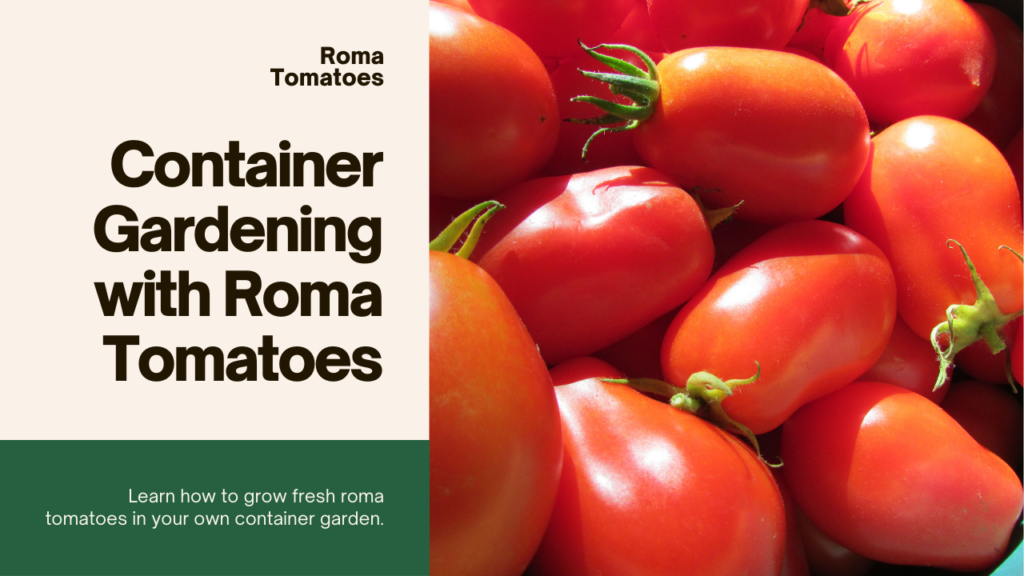
Roma tomatoes are a fantastic choice for container gardening, thanks to their manageable size and high yield. Whether you have a small balcony or a limited garden space, growing Roma tomatoes in containers allows you to enjoy an abundant harvest of these delicious and versatile tomatoes.
When it comes to container gardening, Roma tomatoes offer several advantages. Their compact growth habit means they don’t take up much space, making them ideal for small gardens or urban settings. Additionally, Roma tomatoes are known for their disease resistance, which helps them thrive in the controlled environment of a container.
The high yield of Roma tomatoes is another reason why they are favored by container gardeners. These tomatoes produce an abundance of fruit, ensuring a bountiful harvest throughout the growing season.
The Benefits of Growing Roma Tomatoes in Containers
Container gardening offers numerous benefits for growing Roma tomatoes. Here are some advantages of choosing containers for your Roma tomato plants:
- Space Optimization: Containers allow you to make the most of limited gardening space, making them an excellent choice for small balconies, patios, or even indoor gardens.
- Portability: Containers are portable, allowing you to move your plants to maximize sun exposure or protect them from extreme weather conditions.
- Easy Maintenance: Container gardening typically requires less maintenance than traditional in-ground gardening. It is easier to monitor soil moisture, nutrient levels, and address any specific needs of your Roma tomato plants.
To give you a better understanding of the benefits of growing Roma tomatoes in containers, here’s a comparison table:
| Benefits | Growing Roma Tomatoes in Containers | Growing Roma Tomatoes in Ground |
|---|---|---|
| Space Optimization | ✅ | ❌ |
| Portability | ✅ | ❌ |
| Easy Maintenance | ✅ | ❌ |
| Controlled Environment | ✅ | ❌ |
As you can see, container gardening provides several advantages for growing Roma tomatoes, allowing you to optimize space, maintain control over the growing environment, and easily care for your plants.
Disease Resistance and Yield of Roma Tomatoes
Roma tomatoes are not only well-suited for container gardening but also highly resistant to diseases. This disease resistance is beneficial for both in-ground and container-grown Roma tomato plants.
Here are some common diseases that Roma tomatoes exhibit resistance to:
- Bacterial Wilt
- Fusarium Wilt
- Nematodes
- Tobacco Mosaic Virus
- Verticillium Wilt
“Roma tomatoes are known for their disease resistance, making them an excellent choice for both beginner and experienced gardeners. By choosing Roma tomatoes, you can minimize the risk of your plants succumbing to common diseases, ensuring a successful growing season.”
In addition to disease resistance, Roma tomatoes also offer a high yield. Their robust and prolific nature results in an abundance of juicy, meaty tomatoes that are perfect for sauces, canning, or enjoying fresh off the vine.
Now that you understand the benefits of growing Roma tomatoes in containers and their disease resistance and yield, it’s time to start planning your own container garden. In the next section, we will explore micro tomatoes, another excellent choice for limited space gardening.
Micro Tomatoes: Tiny varieties for tiny spaces
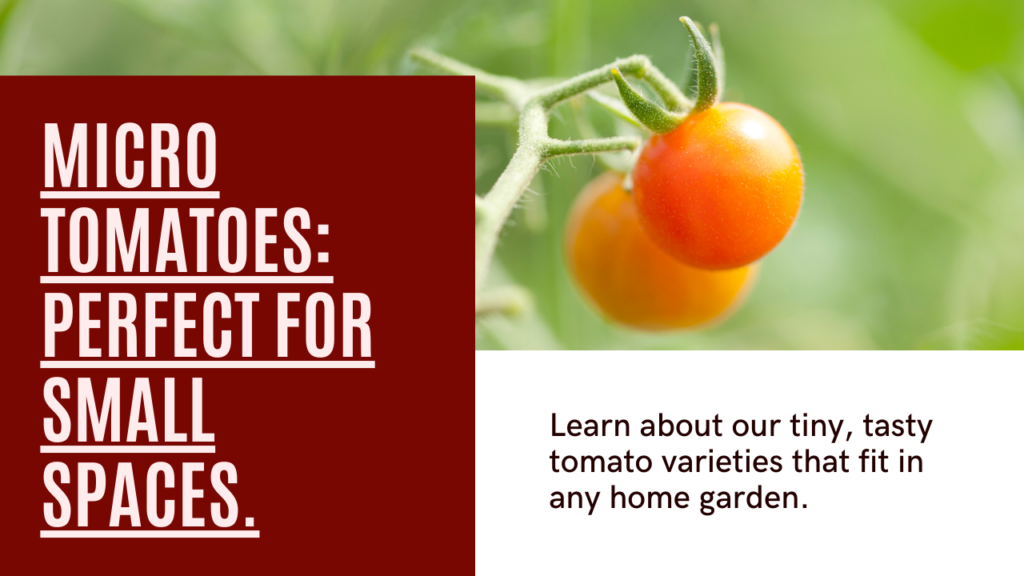
If you have extremely limited space, micro tomatoes are the perfect choice. These tiny tomato varieties require minimal room to grow while still delivering a burst of flavor. Whether you have a small balcony or a compact garden, micro tomatoes can thrive in tight spaces, providing you with homegrown goodness.
When it comes to micro tomatoes, there are several options to consider. Here are some popular varieties:
- Micro Tomatoes A: Ideal for small pots and containers
- Micro Tomatoes B: Compact size, perfect for hanging baskets
- Micro Tomatoes C: Dwarf plants suitable for indoor gardening
To ensure the success of your micro tomato plants, it’s crucial to provide them with the right growing conditions. Here are a few tips:
- Location: Choose a sunny spot for your micro tomatoes. They require at least 6-8 hours of direct sunlight each day to thrive.
- Soil: Use well-draining soil rich in organic matter. Micro tomatoes prefer slightly acidic soil with a pH of 6.0-6.8.
- Watering: Keep the soil consistently moist but avoid overwatering. Regular watering is key to prevent the plants from drying out in small containers.
- Fertilizing: Feed your micro tomatoes with a balanced fertilizer once a month to provide them with essential nutrients for healthy growth.
By following these tips, you can enjoy a bountiful harvest of micro tomatoes in even the tiniest spaces. Their compact size and abundant flavor make them a delightful addition to your limited space garden.
Micro Tomato Comparison
| Micro Tomato Varieties | Height (in inches) | Fruit Size | Flavor |
|---|---|---|---|
| Micro Tomatoes A | 8-12 | Small | Sweet and tangy |
| Micro Tomatoes B | 6-10 | Extra-small | Intense and fruity |
| Micro Tomatoes C | 10-14 | Small | Mild and refreshing |
When choosing micro tomatoes for your small space, consider their height, fruit size, and flavor profile. This comparison table can help you make an informed decision based on your preferences.
Grow your own micro tomatoes and savor their mouthwatering flavors, even in the tiniest of spaces. Whether you’re a seasoned gardener or just starting out, micro tomatoes offer a rewarding experience that brings fresh, homegrown goodness to your table.
Determinate vs. Indeterminate Tomatoes: Choosing the right type for limited space
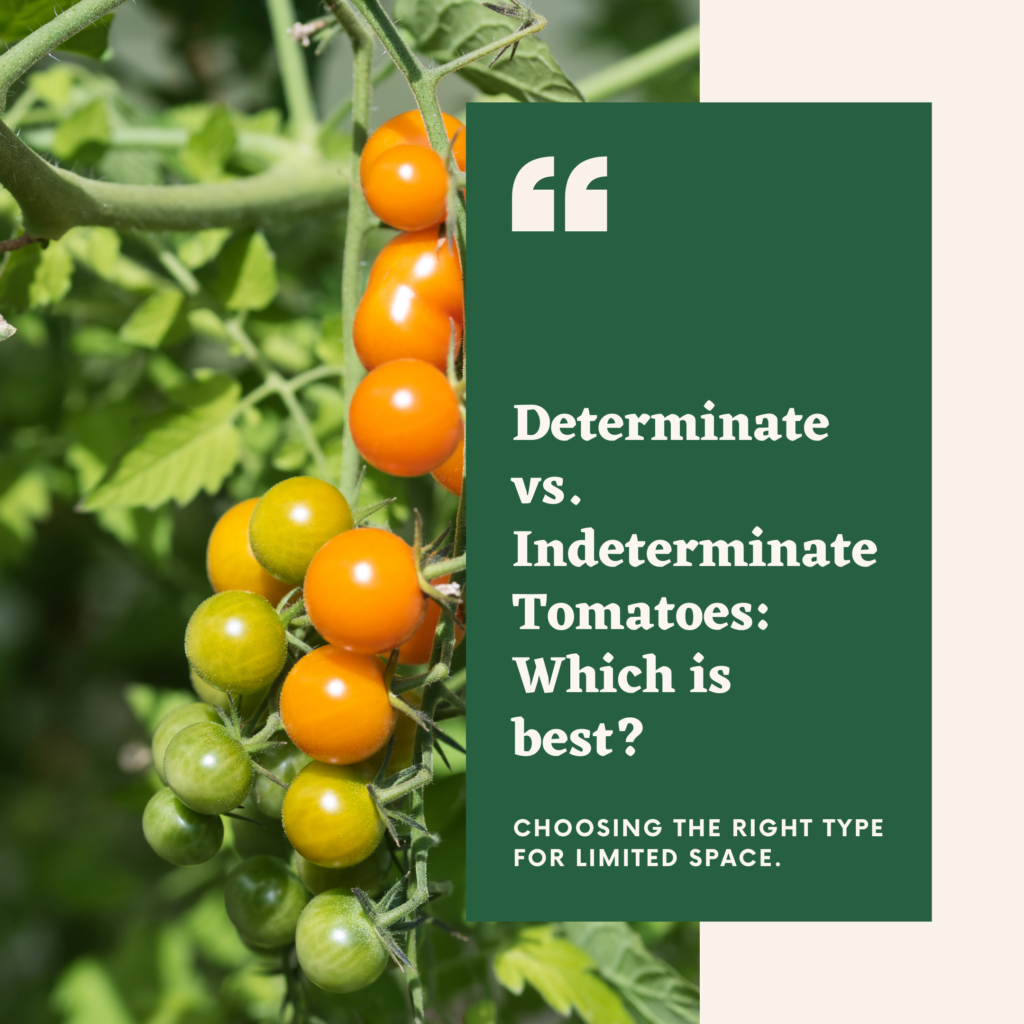
When it comes to growing tomatoes in limited spaces, understanding the difference between determinate and indeterminate varieties is key. Each type has its own unique characteristics, growth habits, and space requirements. By choosing the right type for your limited space garden, you can ensure optimal growth and maximize your tomato harvest. Let’s explore the differences between determinate and indeterminate tomatoes and guide you in making the best choice.
What are Determinate Tomatoes?
Determinate tomatoes are compact varieties that have a predetermined growth habit. They typically grow to a predetermined height, usually around 3 to 4 feet tall, and their fruiting period is relatively short. Determinate tomatoes tend to produce a large crop of tomatoes all at once, making them ideal for gardeners who want a bountiful harvest to process or enjoy at the same time. These varieties are perfect for limited spaces as they require less vertical support and are easier to manage.
What are Indeterminate Tomatoes?
Indeterminate tomatoes, on the other hand, have a more vine-like growth habit. They continue to grow and produce fruit throughout the growing season until frost or disease stops their growth. Indeterminate tomatoes can grow quite tall, reaching heights of 6 to 10 feet or more, depending on the variety. They require sturdy trellising or support structures to keep the vines upright and prevent sprawling. These tomatoes are excellent for gardeners who prefer a steady supply of tomatoes over an extended period.
Now that you understand the basic differences between determinate and indeterminate tomatoes, let’s consider the best choice for your limited space garden:
- If you have a small balcony or patio garden with limited vertical space, determinate tomatoes are a great option. Their compact size and concentrated fruiting period make them ideal for small spaces.
- If you have ample vertical space, such as a tall fence or trellis, or if you enjoy vine-like plants, indeterminate tomatoes will be a perfect choice. They can utilize the vertical space and provide a continuous supply of tomatoes throughout the season.
- If you have limited space but still prefer a longer harvest season, indeterminate tomatoes can be grown in containers with sturdy supports. However, regular pruning and training may be required to control their growth.
Ultimately, the choice between determinate and indeterminate tomatoes depends on your gardening preferences and the specific limitations of your space. Consider factors such as available vertical space, desired harvest duration, and your personal gardening style when selecting the right tomato type for your limited space garden.
With this knowledge, you can now make an informed decision when choosing tomatoes for your limited space garden. Whether you opt for determinate or indeterminate varieties, both can thrive and deliver delicious homegrown tomatoes. In the next section, we will explore the concept of companion planting to further optimize space in your limited space garden.
Companion Planting for Space Optimization
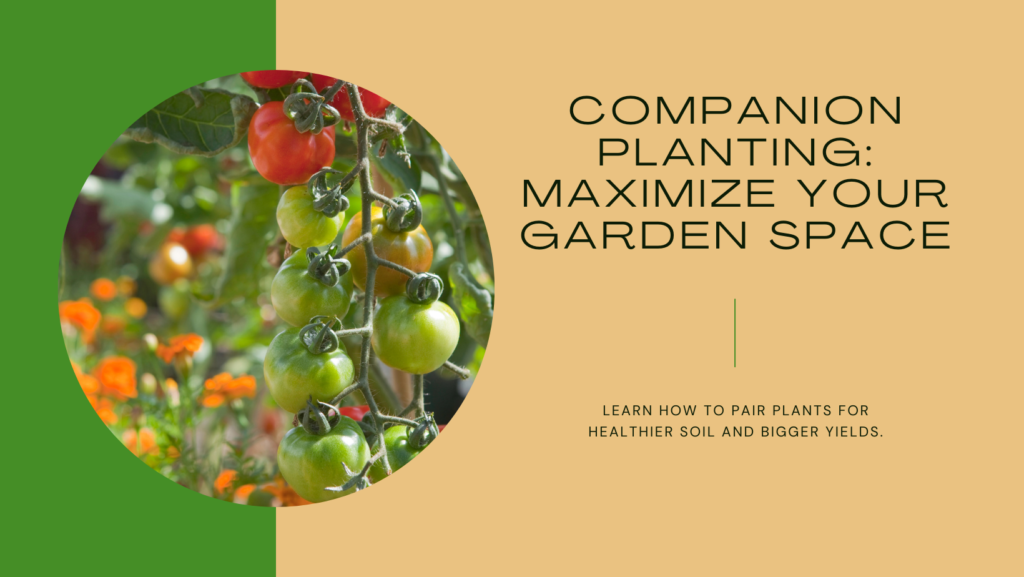
When it comes to maximizing your limited space garden, companion planting is a smart strategy to adopt. By strategically pairing certain plants together, you can optimize your garden’s productivity and make the most of the available space. In this section, we will explore companion plants that work well with tomatoes, enhancing their growth and overall health.
Companion planting involves selecting plants that have mutually beneficial relationships, aiding each other’s growth and deterring pests. In the case of tomatoes, there are several companion plants that can help improve their yield and protect them from common pests and diseases.
The Benefits of Companion Planting with Tomatoes
Companion planting offers a range of benefits for tomatoes:
- Space Optimization: Companion plants can help maximize space in your garden by growing alongside tomatoes, making efficient use of limited space.
- Pest Control: Some companion plants act as natural pest repellents, keeping destructive insects away from your tomato plants.
- Nutrient Enhancement: Certain companion plants can enhance soil fertility and nutrient availability, providing tomatoes with essential nutrients for healthy growth.
- Improved Flavor: Companion plants can contribute to enhanced flavor profiles in tomatoes, making them even more delicious.
Now, let’s take a look at some popular companion plants that work well with tomatoes:
Companion Plants for Tomatoes
| Companion Plant | Benefits |
|---|---|
| Marigolds | Repel harmful nematodes and pests. |
| Basil | Repel tomato hornworms and enhance flavor. |
| Nasturtiums | Attract predatory insects that feed on tomato pests. |
| Borage | Repel tomato hornworms and improve overall plant health. |
These companion plants not only deter pests but also offer other advantages such as enhancing flavor, attracting beneficial insects, and improving overall plant health. By incorporating them into your tomato garden, you can create a holistic and mutually beneficial growing environment.
Remember to consider the specific needs and growth habits of each companion plant when planning your garden to ensure optimal results. Additionally, proper spacing and placement are crucial to avoid overcrowding and competition for resources.
With companion planting, you can make the most of your limited space garden by optimizing productivity and creating a thriving ecosystem. Experiment with different combinations and observe the positive impact on your tomatoes. Your garden will flourish, and you’ll reap the rewards of an efficient, vibrant tomato harvest.
Container Gardening Tips for Small Spaces
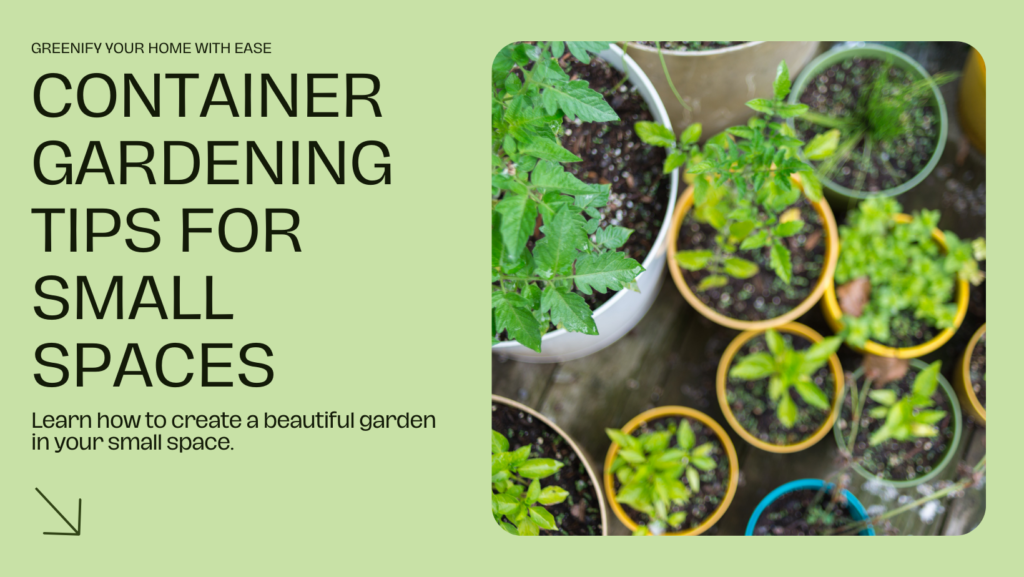
Container gardening is an excellent solution for those with limited space. Whether you have a small balcony, patio, or even a sunny window sill, you can create a thriving garden right at your fingertips. Here are some valuable tips and techniques to ensure success in your container gardening endeavors.
Choose the Right Containers
Select containers that are suitable for the size of your plants and the available space. Opt for lightweight containers made of materials such as plastic or fiberglass, as they are easier to move around. Ensure your containers have adequate draining holes to prevent waterlogged roots.
Use High-Quality Potting Mix
Invest in a high-quality potting mix specifically formulated for container gardening. These mixes are lightweight and provide excellent drainage, promoting optimal root growth. Avoid using regular garden soil, as it tends to compact and restricts root development.
Plan for Proper Drainage and Watering
Ensure proper drainage by placing a layer of gravel, broken terracotta shards, or a coffee filter at the bottom of your pots. This allows excess water to escape and prevents root rot. Water the plants thoroughly but avoid overwatering, as it can lead to fungal diseases. Regularly check the moisture level by sticking your finger into the soil – if it feels dry up to your knuckle, it’s time to water.
Maximize Space with Vertical Gardening
In small spaces, vertical gardening techniques can help maximize your growing area. Use trellises, stakes, or tomato cages to support climbing plants and save horizontal space. When choosing vining varieties, look for compact options that are well-suited for containers.
Consider Companion Planting
Companion planting is a smart technique that utilizes the space efficiently and creates synergistic relationships between plants. For instance, planting leafy greens like lettuce or spinach alongside tomatoes can benefit from the shade provided by the tomato plant while utilizing the space efficiently.
“Container gardening allows you to enjoy the beauty and bounty of nature even in the smallest of spaces.”
Provide Adequate Sunlight
Ensure your container gardens receive the recommended amount of sunlight for the specific plants you’re growing. Most vegetables and herbs require at least 6-8 hours of direct sunlight per day. Place your containers in areas that receive optimal sunlight or consider using grow lights for indoor gardening.
Fertilize Regularly
Container-grown plants rely on the nutrients provided by the potting mix, which can deplete over time. To keep your plants healthy and productive, fertilize them regularly with a balanced water-soluble fertilizer or opt for time-release fertilizers specifically formulated for container gardening.
Monitor Pests and Diseases
Regularly inspect your plants for common pests like aphids, whiteflies, or spider mites. Early detection allows for prompt treatment and helps prevent the spread of infestations. Provide good air circulation around your containers to reduce the risk of fungal diseases, and promptly remove any diseased leaves or plants to prevent further damage.
By following these container gardening tips and techniques, you can transform your small space into a flourishing garden. Enjoy the satisfaction of growing your own fresh produce, herbs, or colorful flowers, even in the coziest of spaces.
Sunlight and Watering Needs for Tomatoes in Limited Spaces
In order for your tomatoes to thrive in limited spaces, it’s essential to understand their sunlight and watering requirements. Properly meeting these needs will ensure healthy growth and abundant harvests. Read on to discover the specific guidelines for providing adequate sunlight and watering for your tomatoes in small gardens.
Sunlight Requirements for Tomatoes
Tomatoes are known for their love of sunlight, as it plays a crucial role in their growth and fruit production. When planting tomatoes in limited spaces, such as balconies or small gardens, it’s important to choose a location that receives ample sunlight. Ideally, tomatoes require at least 6-8 hours of direct sunlight every day. This allows them to produce the energy necessary for photosynthesis, which is the process that fuels their growth.
To ensure your tomato plants receive sufficient sunlight, follow these tips:
- Choose a location that is not shaded by nearby structures or trees.
- Position pots or containers in areas that receive maximum sunlight exposure throughout the day.
- Rotate your containers periodically to ensure all sides of the plant receive an equal amount of sunlight.
- If growing tomatoes indoors, use grow lights or place them near a bright and sunny window.
By providing your tomatoes with the necessary sunlight, you’ll promote strong growth, vibrant foliage, and ultimately, flavorful fruits.
Watering Techniques for Tomatoes
Proper watering is equally essential for the health and productivity of your tomatoes. While they require consistent moisture, overwatering can lead to root rot and other problems. Follow these guidelines to water your tomatoes effectively:
- Water your tomato plants deeply, aiming for the soil to be thoroughly moistened.
- Water at the base of the plant, directly onto the soil, rather than sprinkling from above. This helps prevent fungal diseases and ensures water reaches the roots.
- Allow the soil to dry out slightly between waterings. Tomatoes prefer well-draining soil, so avoid excessive moisture.
- Monitor the moisture levels by inserting your finger about an inch into the soil. If it feels dry, it’s time to water.
- Avoid wetting the foliage as this can promote the growth of diseases. Instead, focus on watering the root zone.
Remember, the watering needs of tomatoes may vary depending on the weather, container size, and other environmental factors. Regularly assess the soil’s moisture levels to ensure you’re providing the appropriate amount of water for your tomato plants.
| Sunlight Needs | Watering Guidelines |
|---|---|
| At least 6-8 hours of direct sunlight per day | Water deeply, ensuring the soil is thoroughly moistened. Allow the soil to dry out slightly between waterings. |
| By meeting these requirements, your tomatoes will thrive and reward you with delicious harvests. | |
Tomato Cage and Trellis Systems for Space Optimization
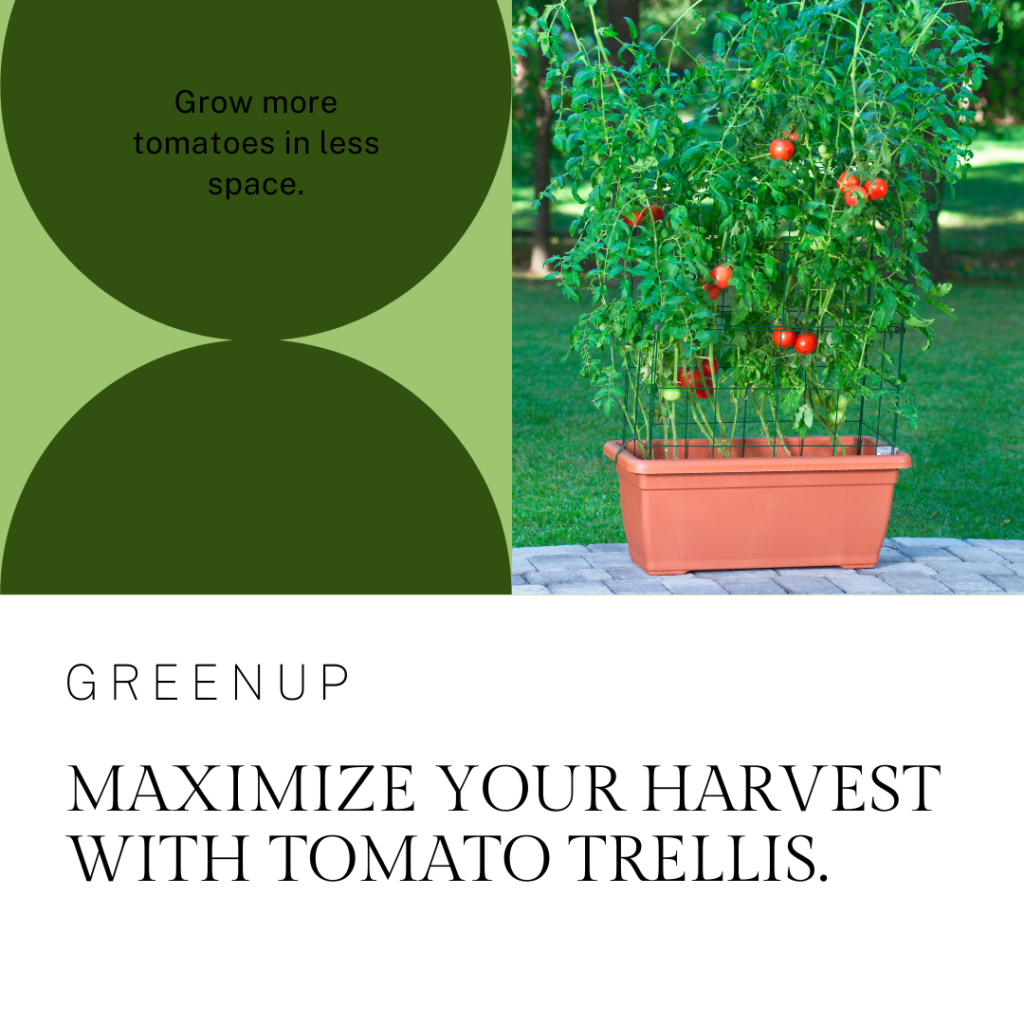
In limited gardens, space optimization is key to maximizing your tomato harvest. Tomato cages and trellis systems are practical solutions that provide support for your tomato plants while efficiently utilizing space. Let’s explore various options of tomato cages and trellis systems, discuss their benefits, and learn how to effectively use them in your small space garden.
If you’re growing determinate or bushy tomato varieties, tomato cages are an excellent choice. These cages are sturdy structures made of metal or plastic that surround individual plants, keeping them upright and preventing sprawling. Tomato cages not only support the plants but also help optimize space by keeping the branches contained within the cage’s boundaries. This prevents overcrowding, promotes good airflow, and makes it easier to access the tomatoes for harvesting.
If you’re growing indeterminate or vining tomato varieties, trellis systems are highly recommended. Trellises provide vertical support, allowing the tomato plants to grow upwards rather than spreading out horizontally. This vertical growth not only saves space but also helps increase air circulation and sunlight exposure, leading to healthier plants and higher yields. There are various types of trellis systems available, including stakes, cages with built-in trellises, and DIY trellises made from bamboo or wire mesh.
Trellis System Benefits:
- Space-saving: Trellises allow vertical growth, making the most of limited space.
- Better air circulation: Vertical growth enhances airflow, reducing the risk of diseases.
- Enhanced sunlight exposure: Plants can access more sunlight, aiding in photosynthesis and fruit development.
- Easier harvesting: With plants neatly trained upwards, picking tomatoes becomes more convenient.
Using Tomato Cages and Trellis Systems:
To effectively use tomato cages, place them around each tomato plant when they are still relatively small. As the plants grow, gently guide the branches within the cage, ensuring they stay upright and supported. Secure the cage firmly in the ground to prevent tipping or falling over due to the weight of the plant and fruits.
Trellis systems require a bit more planning. Install the trellis structure before planting your tomatoes, positioning it securely in the ground or attaching it to a wall or fence. As the plants grow, gently tie the vines to the trellis using soft plant ties or twine. Encourage the main stem to grow vertically, redirecting any side shoots towards the trellis. Regularly prune and remove excess foliage to maintain airflow and prevent overcrowding.
By using tomato cages and trellis systems, you can optimize your limited space and enjoy a thriving tomato garden. These structures provide vital support, prevent sprawling, promote optimal airflow and sunlight exposure, and make harvesting a breeze. Explore the wide range of options available and choose the one that best suits your gardening needs. Happy gardening!
“Tomato cages and trellis systems are space-saving solutions that support tomato plants and maximize yields in limited gardens.”
Pests and Disease Management in Limited Space Tomato Gardens
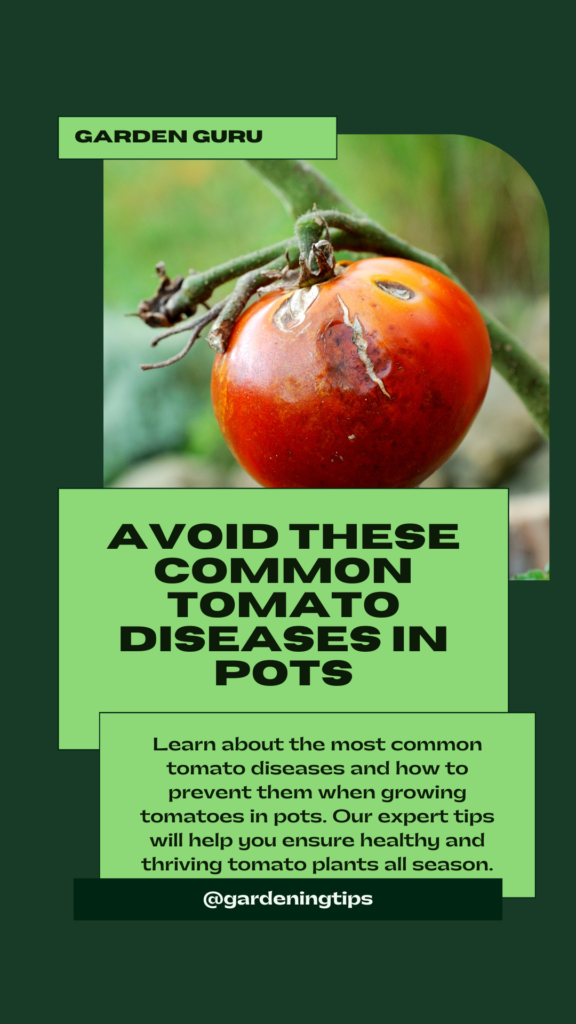
Even in limited space tomato gardens, pest and disease management is crucial to ensure healthy and productive plants. In this section, we will discuss common pests and diseases that can affect tomato plants in small gardens and provide tips for effective management and prevention.
Common Tomato Pests
Pests can cause significant damage to tomato plants, leading to stunted growth, reduced yield, and even plant death. Here are some common tomato pests to watch out for:
- Aphids: These small, soft-bodied insects feed on the sap of tomato plants, causing yellowing of leaves and the presence of sticky residue.
- Tomato Hornworms: These large caterpillars can strip the leaves and fruits of tomato plants, causing severe damage.
- Whiteflies: These tiny, white insects feed on tomato plants’ sap, leading to stunted growth and the spread of viral diseases.
- Spider Mites: These tiny pests suck the sap from tomato plants, causing yellowing leaves and the presence of webbing.
- Thrips: These slender insects can damage tomato plants by feeding on leaves and spreading viral diseases.
To manage and control pests in your limited space tomato garden, consider the following strategies:
- Regular inspections: Check your tomato plants regularly for signs of pest infestation. Early detection allows for prompt action.
- Natural predators: Encourage beneficial insects such as ladybugs and lacewings, which feed on pests, by planting companion plants that attract them.
- Handpicking: If you spot pests on your tomato plants, manually remove them and drop them into a bucket of soapy water to eliminate the infestation.
- Organic sprays: Use organic insecticidal sprays, such as neem oil or insecticidal soap, to control pest populations. Follow the instructions carefully.
Common Tomato Diseases
In addition to pests, tomato plants in limited space gardens can be susceptible to various diseases. Here are some common tomato diseases to be aware of:
- Early Blight: This fungal disease causes brown spots on tomato leaves, leading to defoliation and decreased fruit production.
- Late Blight: Late Blight is a devastating fungal disease that can quickly destroy tomato plants, causing dark, water-soaked lesions on leaves and fruits.
- Tomato Fusarium Wilt: This soil-borne disease causes wilting, yellowing leaves, and stunted growth in tomato plants.
- Tomato Verticillium Wilt: Another soil-borne disease, Verticillium wilt, affects the vascular system of tomato plants, causing wilting and yellowing.
- Blossom End Rot: Blossom end rot is a physiological disorder that results in dark, sunken lesions at the bottom of tomato fruits.
To manage and prevent tomato diseases in limited space gardens, follow these tips:
- Proper sanitation: Keep your garden clean by removing debris and dead plant material that can harbor disease-causing organisms.
- Good air circulation: Provide adequate spacing between tomato plants to promote airflow and reduce humidity levels, which can contribute to disease development.
- Regular watering: Avoid overwatering or underwatering tomato plants, as inconsistent moisture levels can increase the risk of certain diseases.
- Healthy soil: Maintain well-draining soil rich in organic matter to promote strong plant growth and enhance disease resistance.
- Resistant varieties: Consider planting tomato varieties that are resistant to specific diseases prevalent in your region.
Implementing proper pest and disease management techniques will help ensure the success of your limited space tomato garden. By carefully monitoring your plants, practicing preventive measures, and taking swift action when needed, you can enjoy a bountiful harvest of healthy, flavorful tomatoes.
FAQ
Q. What are the best tomatoes for limited space gardening?
A. The best tomatoes for limited space gardening are compact cherry tomatoes, patio tomatoes, Roma tomatoes, and micro tomatoes. These varieties are specifically bred to thrive in small spaces and offer a range of flavors to suit every gardener’s taste.
Q. Why are cherry tomatoes ideal for limited space gardening?
A. Cherry tomatoes are perfect for limited space gardening due to their compact growth habits. They take up less space than traditional tomato varieties while still offering a burst of flavor. Plus, they come in a wide range of varieties and flavors, allowing you to enjoy different taste profiles in your limited garden.
Q. What are patio tomatoes and why are they good for small gardens?
A. Patio tomatoes are compact tomato varieties specifically bred to thrive in small gardens, such as balconies and patios. They are ideal for small gardens because they have a compact growth habit, taking up less space while still producing a good yield. Patio tomatoes are perfect for those with limited gardening areas.
Q. How do I care for patio tomatoes in small gardens?
A. To care for patio tomatoes in small gardens, make sure to choose a suitable pot with good drainage, provide ample sunlight, water consistently, and fertilize regularly. It’s also important to provide support such as stakes or tomato cages as the plants grow.
Q. What are Roma tomatoes and why are they great for container gardening?
A. Roma tomatoes are versatile tomato varieties that are well-suited for container gardening due to their manageable size and high yield. They are known for their meaty texture, making them perfect for sauces and canning. Growing Roma tomatoes in containers allows you to enjoy a bountiful harvest even in limited spaces.
Q. Are Roma tomatoes disease-resistant and high-yielding?
A. Yes, Roma tomatoes are generally disease-resistant and high-yielding. They are known for their resistance to various tomato diseases, making them a popular choice for gardeners. With proper care and maintenance, Roma tomatoes can produce a generous harvest even in limited space gardens.
Q. What are micro tomatoes and why are they suitable for tiny spaces?
A. Micro tomatoes are tiny tomato varieties that are perfect for extremely limited spaces. They require minimal room to grow, making them an excellent choice for small gardens, balconies, or even windowsills. Despite their size, micro tomatoes still pack a flavorful punch.
Q. What growing conditions and sunlight do micro tomatoes need?
A. Micro tomatoes need at least 6-8 hours of direct sunlight per day to thrive. Ensure that they are planted in well-draining soil and watered consistently. These tiny tomato plants can be grown in containers or hanging baskets, making them a great choice for those with limited gardening space.
Q. What are the differences between determinate and indeterminate tomatoes?
A. Determinate tomatoes are compact and bushy, reaching a certain height and then stopping their vertical growth. They are ideal for small gardens as they require less staking and pruning. Indeterminate tomatoes, on the other hand, are vining and continue to grow throughout the season. They often require support and more space to accommodate their vertical growth.
Q. What are some companion plants that work well with tomatoes in limited space gardens?
A. Some companion plants that work well with tomatoes in limited space gardens include herbs like basil and parsley, flowers like marigolds and nasturtiums, and vegetables like peppers and onions. These plants can provide pest control, attract pollinators, and enhance the overall productivity of your tomato plants.
Q. What are some container gardening tips for small spaces?
A. When container gardening in small spaces, make sure to choose the right-sized pots with good drainage, use high-quality potting soil, provide adequate watering and fertilization, and regularly monitor the plants for any signs of pests or diseases. Additionally, consider vertical gardening techniques to maximize your limited space.
Q. How much sunlight do tomatoes in limited spaces need, and how often should they be watered?
A. Tomatoes in limited spaces typically need at least 6-8 hours of direct sunlight per day to thrive. As for watering, it’s important to keep the soil consistently moist but not waterlogged. Water deeply whenever the top inch of soil feels dry, and adjust the frequency based on the weather conditions and the specific needs of your tomato plants.
Q. What are some tomato cage and trellis systems that can optimize space in limited gardens?
A. There are various tomato cage and trellis systems available that can help optimize space in limited gardens. Some popular options include cone-shaped tomato cages, stake and string trellises, and vertical gardening solutions like trellis netting or portable trellis panels. These systems provide support for your tomato plants while utilizing vertical space effectively.
Q. How can I manage pests and diseases in my limited space tomato garden?
A. To manage pests and diseases in a limited space tomato garden, practice good garden hygiene, monitor your plants regularly for any signs of trouble, and promptly address any issues that arise. Consider using organic pest control methods such as insecticidal soaps or neem oil and be proactive in preventing common tomato diseases through proper watering, spacing, and crop rotation.
Conclusion
With the right choice of tomato varieties and proper gardening techniques, even limited spaces can yield a bountiful tomato harvest. Whether you have a small garden oasis or a cozy balcony, you can enjoy the flavors of homegrown tomatoes.
By considering compact cherry tomatoes, patio tomatoes, Roma tomatoes, and micro tomatoes, you have a variety of options to suit your limited space gardening needs. These tomato varieties are specifically bred or naturally compact, making them ideal for small gardens.
Implement the tips and strategies shared in this article for a successful limited space tomato garden. From companion planting to container gardening, there are various techniques to optimize your space and maximize productivity. Pay attention to sunlight and watering needs, choose the right type of tomatoes based on their growth habits, and consider using tomato cages or trellis systems for support.
So, whether you’re a gardening enthusiast or a beginner, don’t let limited space hold you back from enjoying the taste of fresh, homegrown tomatoes. Get started with your own limited space tomato garden and experience the joy of harvesting your own delicious tomatoes.


